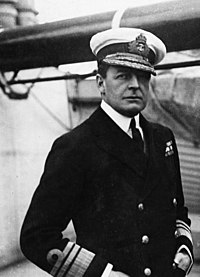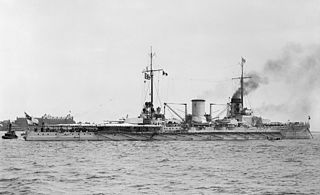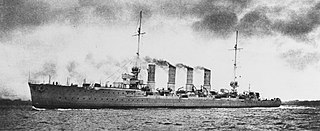
The Battle of Heligoland Bight was the first Anglo-German naval battle of the First World War, fought on 28 August 1914, between ships of the United Kingdom and Germany. The battle took place in the south-eastern North Sea, when the British attacked German patrols off the north-west German coast. The German High Seas Fleet was in harbour on the north German coast while the British Grand Fleet was out in the northern North Sea. Both sides engaged in long-distance sorties with cruisers and battlecruisers, with close reconnaissance of the area of sea near the German coast—the Heligoland Bight—by destroyer.

The Battle of Dogger Bank was a naval engagement during the First World War that took place on 24 January 1915 near the Dogger Bank in the North Sea, between squadrons of the British Grand Fleet and the Kaiserliche Marine. The British had intercepted and decoded German wireless transmissions, gaining advance knowledge that a German raiding squadron was heading for the Dogger Bank and ships of the Grand Fleet sailed to intercept the raiders.

Rear Admiral Sir Horace Lambert Alexander Hood, was a Royal Navy admiral of the First World War, whose lengthy and distinguished service saw him engaged in operations around the world, frequently participating in land campaigns as part of a shore brigade. His early death at the Battle of Jutland in the destruction of his flagship HMS Invincible was met with mourning and accolades from across Britain.

The Battle of Jutland was fought on 31 May and 1 June 1916, in the waters of the North Sea, between forces of the Royal Navy and Imperial German Navy. The battle involved 250 warships, and, in terms of combined tonnage of vessels engaged, was the largest naval battle in history.
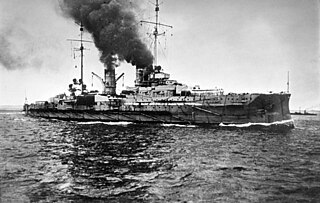
SMS Blücher was the last armored cruiser built by the German Empire. She was designed to match what German intelligence incorrectly believed to be the specifications of the British Invincible-class battlecruisers. Blücher was larger than preceding armored cruisers and carried more heavy guns, but was unable to match the size and armament of the battlecruisers which replaced armored cruisers in the British Royal Navy and German Imperial Navy. The ship was named after the Prussian Field Marshal Gebhard von Blücher, the commander of Prussian forces at the Battle of Waterloo in 1815.

Hans Hermann Ludwig von Reuter was a German admiral who commanded the High Seas Fleet when it was interned at Scapa Flow in the north of Scotland at the end of World War I. On 21 June 1919 he ordered the scuttling of the German fleet in Scapa Flow to prevent the UK from seizing the ships.

Admiral of the Fleet Roger John Brownlow Keyes, 1st Baron Keyes, was a British naval officer.

Leberecht Maass was the Konteradmiral who commanded the German naval forces at the first Battle of Heligoland Bight. He lost his life when his flagship, the light cruiser SMS Cöln, was sunk by British battlecruisers commanded by Vice Admiral David Beatty.

Rear Admiral Sir Robert Keith Arbuthnot, 4th Baronet, was a Royal Navy officer during the First World War. He was killed at the Battle of Jutland, when the cruiser squadron he commanded came under heavy fire after a bold but ill-judged attack on the German battle fleet.

Operation Albion was a World War I German air, land and naval operation against the Russian forces in October 1917 to occupy the West Estonian Archipelago. The campaign aimed to occupy the Baltic islands of Saaremaa(Ösel), Hiiumaa (Dagö) and Muhu (Moon). The three islands were part of the Russian Empire and strategically dominated the central and northern Baltic Sea. The land campaign opened with German landings at the Tagalaht (Tagga) bay on the island of Saaremaa (Ösel), on 12 October, after extensive naval operations to clear mines and subdue coastal artillery batteries. German forces secured the island by 16 October and the Russian army evacuated Muhu (Moon) on 20 October.

The Raid on Scarborough, Hartlepool and Whitby on 16 December 1914 was an attack by the Imperial German Navy on the British ports of Scarborough, Hartlepool, West Hartlepool and Whitby. The bombardments caused hundreds of civilian casualties and resulted in public outrage in Britain against the German Navy for the raid and the Royal Navy for failing to prevent it.

HMS Fearless was one of three Active-class scout cruisers built for the Royal Navy shortly before the First World War. Upon completion in 1913, the ship was assigned to the 1st Light Cruiser Squadron (LCS) of the 1st Fleet. She became flotilla leader of the 1st Destroyer Flotilla (DF) shortly before the start of the war in August 1914 and was transferred to the Harwich Force shortly after it began. Fearless participated in the Battle of Heligoland Bight and the Cuxhaven Raid later that year. The ship was transferred to the Grand Fleet in early 1915 and played a minor role in the Battle of Jutland the following year.

HMS Defender was an Acheron-class destroyer which was built in 1911, served throughout World War I and was broken up in 1921. She was the fifth ship of the name to serve in the Royal Navy.

The Raid on Yarmouth, on 3 November 1914, was an attack by the Imperial German Navy on the British North Sea port and town of Great Yarmouth. German shells only landed on the beach causing little damage to the town, after German ships laying mines offshore were interrupted by British destroyers. The British submarine HMS D5 was sunk by a German mine as it was leaving harbour to attack the German ships. A German armoured cruiser was sunk after striking two German mines outside its home port.

The Harwich Force originally called Harwich Striking Force was a squadron of the Royal Navy, formed during the First World War and based in Harwich. It played a significant role in the war.

HMS Attack was an Acheron-class destroyer built in 1911, which served during the First World War and was sunk in 1917 in the Mediterranean by a German U-boat. She was the third ship of the name to serve in the Royal Navy.

The Battle of Jutland took place in the North Sea between the German High Seas Fleet and British Grand Fleet on the afternoon and evening of 31 May 1916, continuing sporadically through the night into the early hours of 1 June. The battle was the only direct engagement between the two fleets throughout World War I. The war had already been waged for two years without any major sea battle, and many of the people present did not expect that this patrol would end differently. Lack of experience still accounted for a number of mistakes by the combatants. The battle has been described in a number of phases, the last of which is the subject of this article.

Admiral Sir Lewis Bayly, was a Royal Navy officer who served during the First World War.
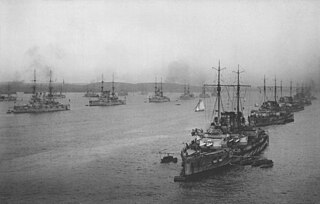
The II Battle Squadron was a unit of the German High Seas Fleet before and during World War I. The squadron saw action throughout the war, including the Battle of Jutland on 31 May – 1 June 1916, where it formed the rear of the German line.
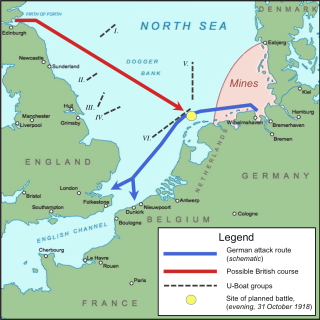
The naval order of 24 October 1918 was a plan made by the German Admiralty to provoke a decisive battle between the German High Seas Fleet and the British Grand Fleet in the southern North Sea in the final weeks of World War I. It was drawn up contrary to the wishes and without the knowledge of the German government. When the order to prepare for the sortie was issued on 29 October, mutiny broke out aboard some of the German ships stationed at Wilhelmshaven. Despite the cancellation of the operation, the sailors' revolt led to the more serious Kiel mutiny, which began the German Revolution of 1918-19 and the establishment of the Weimar Republic.

